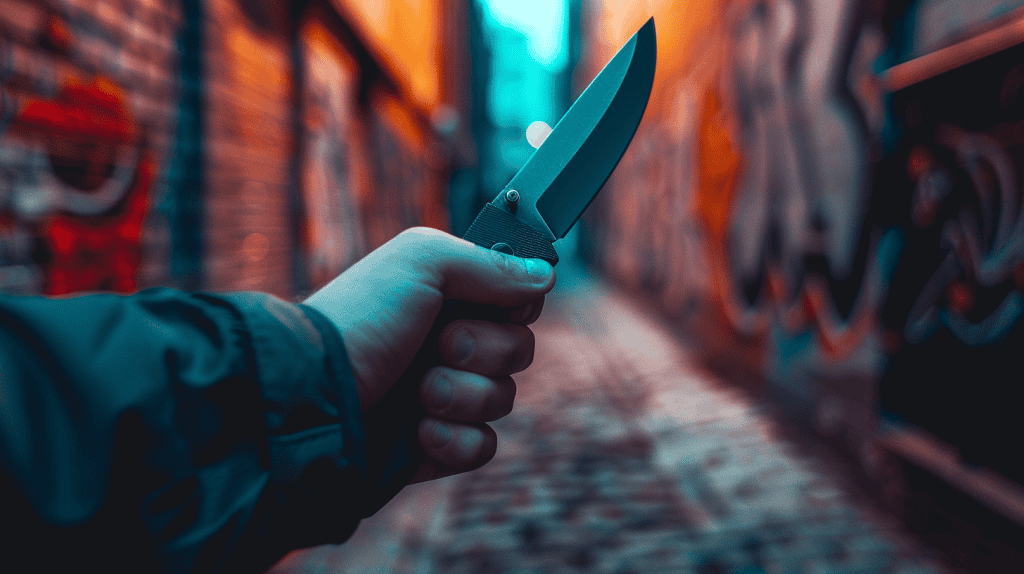A pocket knife can be effective for self-defense but comes with significant caveats. Its compactness and quick deployment are assets, yet the risks, such as accidental self-injury and violence escalation, are substantial. Legal considerations also play an essential role; laws vary widely, making it is vital to know your local regulations. Practical use requires consistent training to handle stress, where fine motor skills may falter. Safer alternatives, like pepper spray or personal alarms, offer non-lethal options with less legal ambiguity. Understanding these aspects will help you make a more informed decision about carrying a pocket knife for self-defense.
Key Takeaways
- Pocket knives offer versatility and quick deployment in high-stress self-defense situations.
- Legal restrictions on pocket knives vary widely, requiring awareness of local regulations.
- Lack of training and composure can lead to self-harm during altercations involving pocket knives.
- Introducing a knife can escalate violence and perceived threat levels in confrontations.
Advantages of Pocket Knives
 Pocket knives offer several practical advantages for self-defense. One of the primary benefits is their role as a versatile tool. A well-designed pocket knife can serve multiple purposes beyond self-defense, such as cutting rope, opening packages, or preparing food. This multifunctionality guarantees you’re always equipped to handle various situations, making it an invaluable addition to your everyday carry (EDC) items.
Pocket knives offer several practical advantages for self-defense. One of the primary benefits is their role as a versatile tool. A well-designed pocket knife can serve multiple purposes beyond self-defense, such as cutting rope, opening packages, or preparing food. This multifunctionality guarantees you’re always equipped to handle various situations, making it an invaluable addition to your everyday carry (EDC) items.
Moreover, pocket knives are compact and easily concealable, enhancing their self-defense practicality. You can carry one discreetly in your pocket or bag or attach it to a keychain, guaranteeing immediate access when needed. The ease of access and quick deployment can be vital in high-stress situations where every second counts.
Research indicates that a self-defense tool can increase your confidence and sense of security. Pocket knives fit this role exceptionally well with their dual utility and ease of carry. Additionally, many models are designed with safety features like locking mechanisms to prevent accidental injury, further solidifying their suitability for EDC.
Drawbacks and Risks
Despite their many advantages, carrying a pocket knife for self-defense has significant drawbacks and risks.
One of the primary concerns is the self-harm risks involved. In the heat of an altercation, you mightn’t have the skill or composure to handle the knife effectively, which can lead to accidental injury to yourself. Data shows that many individuals who carry knives for self-defense end up sustaining injuries from their weapons during confrontations.
Another critical issue is the escalation potential. Introducing a knife into a volatile situation can escalate the level of violence, potentially turning a non-lethal encounter into a deadly one. Studies indicate that aggressors are more likely to use lethal force if they perceive a significant threat, such as a knife. This can put you at a higher risk rather than safeguarding you.
Furthermore, carrying a knife requires constant training and practice to use it effectively and safely. Without proper training, the knife can become a liability rather than an asset. It’s crucial to weigh these risks carefully, considering whether other self-defense options offer less potential for harm and escalation.
Legal Considerations
 Understanding the legal implications of carrying a knife for self-defense is essential before making it a part of your safety strategy. You must know about various jurisdictions with different self-defense laws and weapon classifications. While seemingly benign, a pocket knife can be classified as a weapon in many places, leading to legal complications if misused.
Understanding the legal implications of carrying a knife for self-defense is essential before making it a part of your safety strategy. You must know about various jurisdictions with different self-defense laws and weapon classifications. While seemingly benign, a pocket knife can be classified as a weapon in many places, leading to legal complications if misused.
To help you navigate these legal waters, consider the following table that outlines key aspects of knife laws in different regions:
| Region | Legal Blade Length | Concealed Carry Restrictions |
|---|---|---|
| United States | Varies by state | Some states restrict |
| United Kingdom | Under 3 inches | Strictly regulated |
| Canada | No automatic knives | Prohibited |
| Australia | Under 5.5 inches | License required |
Understanding these restrictions can prevent you from inadvertently violating self-defense laws. For instance, in the United Kingdom, carrying a knife with a blade longer than 3 inches can result in severe penalties unless you have a legitimate reason. In the United States, laws vary widely by state, so it’s vital to familiarize yourself with local regulations.
Practicality in Real-Life Scenarios
While knowing the legal aspects is essential, you must also evaluate how practical a pocket knife is for self-defense in real-life situations.
Speed and accessibility are vital in self-defense scenarios. A pocket knife, while compact, requires you to retrieve, open, and position it for use, which can be challenging under stress. Studies indicate that fine motor skills deteriorate during high-stress events, complicating the knife’s deployment.
Additionally, personal safety should be your top priority. Handling a knife requires skill and training to use effectively without risking personal injury. If not properly trained, you might inadvertently harm yourself more than your attacker. Research shows that visible weapons often deter attackers, but this isn’t a guaranteed outcome.
Moreover, self-defense scenarios often involve close-quarters combat, where a pocket knife mightn’t provide a significant advantage. In such situations, the effectiveness of a pocket knife can be limited compared to other self-defense tools.
Alternatives to Pocket Knives
When considering alternatives to pocket knives for self-defense, you might find options that are easier to deploy and potentially more effective in high-stress situations. Various self-defense tools and personal safety gadgets are designed to provide quick and reliable protection.
- Pepper Spray: A highly effective self-defense tool, pepper spray can incapacitate an attacker from a distance of up to 10 feet. It’s easy to carry and legal in most places.
- Stun Guns: These devices deliver a high-voltage shock that can temporarily disable an assailant. They often come in compact sizes, making them convenient to carry.
- Personal Alarms: When activated, these gadgets emit a loud, attention-grabbing noise, which can deter attackers and attract help. They’re lightweight and can be attached to your keychain.
- Tactical Pens: These pens function as writing instruments and self-defense weapons. They’re built with solid materials and can be used to strike an assailant.
- Kubotans: Small and discreet, kubotans can be attached to your keychain. They apply pressure to sensitive areas, helping you escape from dangerous situations.
Incorporating these alternatives into your self-defense strategy can enhance your safety. They offer reliable protection without the complexities associated with pocket knives.



